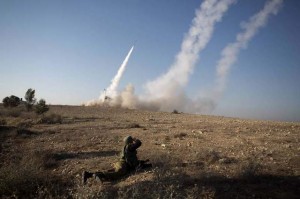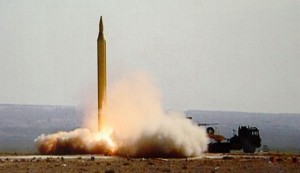2012-11-30 by Robbin Laird
The 1982 Lebanese War was a significant event on many levels.
But one of those levels was the testing of military equipment and operational approaches.
The Israelis used new unmanned aerial vehicles, new weapons against tanks, and new approaches to air-ground operations to defeat its enemies in Lebanon.
One of those weapons was the T-72 tank, which at the time was the best Soviet tank in play. And the Israelis demonstrated that using advanced TOW missiles, UAVs and other air assets together could decisively affect ground operations.
These lessons would be seen on a larger stage in the Gulf War in 1991, but the Bekaa valley was a trial run for a version of air-land battle being shaped by NATO to confront the Soviet forces in Europe.
Later air-land battle would be redeployed to the Gulf with the Iraqi regime the replacement for the Soviet Union.
We may well have seen a new iteration of what happened in 1982.

The Iranians are testing their missiles and various bunker approaches to hiding and then deploying those missiles via operations on the borders of Israel.
And Israel has responded by shaping their version of the new approach to attack and defense enterprise, which is evolving in the Pacific.
The new version of air land battle will be an attack defense enterprise to be played out in the Pacific.
The evolution of 21st century weapon systems and capabilities is breaking down the barriers between offensive and defensive systems. Is missile defense about defense or is it about providing capabilities for global reach, for offense or defense? And the new 5th generation aircraft have been largely not understood because they are inherently multi-mission systems, which can be used for forward defense or forward offensive operations.
Indeed, an inherent characteristic of many new systems is that they are really about presence and putting a grid over an operational area, and can be used to support strike or defense within an integrated approach. In the 20th Century, surge was built upon the notion of signaling. One would put in a particular combat capability, Carrier Battle Group, Amphibious Ready Group, Air Expeditionary Wing, to put down your marker and to warn a potential adversary that you were there and ready to be taken seriously. If one needed to, additional forces would be sent in to escalate, and build up force.
With the new multi-mission systems – 5th generation aircraft and Aegis for example – the key is presence and integration able to support strike or defense in a single operational presence capability. Now the adversary can not be certain that you are simply putting down a marker that has its means fundamentally based on your ability to bring in dominant forces.
This is what Secretary Wynne calls the attack and defense enterprise.
The strategic thrust of integrating modern systems is to create a grid that can operate in an area with into a seamless whole able to strike or defend simultaneously.
https://sldinfo.com/shaping-an-attack-and-defense-enterprise-for-the-pacific/
The Israelis have unveiled their version, 40 years after the Bekaa Valley operation anticipated air land battle. Here the Israelis used combined arms to provide a 360-degree attack and defense approach.
Special forces and various ground elements combined with air strikes, suppression and new weapons to destroy bunkers along with the Iron Dome to mitigate the effects from the underground missile force which sought to provide wanton attacks on Israel itself.
Counter value targeting based on underground storage and pop up strikes of missiles – salvos of missiles – was defeated by a 360-degree attack and defense enterprise. This version remains not as tightly integrated, as new technologies will allow but the concept is already battle proven.
Much like testing in 1982, 2012 has seen the next phase of response to regimes such as Iran. An attack and defense enterprise is crucial to defeat the evolving threats facing US and allied forces.
Much like in 1982, the Israelis have tested the waters.
Obviously this is an ongoing story and operation.
Israeli spy satellites have spotted an Iranian ship being loaded with missiles that analysts say may be headed for Gaza, The Sunday Times reported.
According to the report, the cargo may include Fajr-5 rockets, like those that were fired by Hamas toward Israel and the stockpiles of which the Israel Defense Forces depleted during the recent round of fighting across the Gaza border, in addition to Shahab-3 ballistic missiles, which could be stationed in Sudan to pose a direct threat to Israel.
“With a lot of effort, Iran has skillfully built a strategic arm pointing at Israel from the south,” an Israeli source was quoted as saying.
The cargo would travel via the Red Sea, Sudan and Egypt, following a well-established route used by Iran to smuggle arms into Gaza, the Times reported.
“We believe that Iranian warships anchored in Eritrea will accompany the weapons ship as soon as it enters the Red Sea,” an Israeli source told the Times.
The shipment was reportedly prepared last week, at the same time as Israel and Hamas agreed to a cease-fire that would end the eight-day long Operation Pillar of Defense.
“Regardless of the cease-fire agreement, we will attack and destroy any shipment of arms to Gaza once we have spotted it,” an Israeli defense source told the Times.
On Saturday, Reuters reported that senior Hamas leader Mahmoud al-Zahar said Hamas would continue to arm itself with the help of Iran, though the truce signed in Cairo calls for a cessation of rocket fire at Israel, which Israel gave as its reason for launching its attacks in mid-November.
“We have no choice but to continue to bring in weapons by all possible means,” Zahar said, adding that he expected Tehran would “increase its military and financial support to Hamas”.
“We have a right to take money and weapons from Iran. They (Iran) give to us for the sake of God, no conditions attached, and I am a witness to that,” Zahar told reporters.


